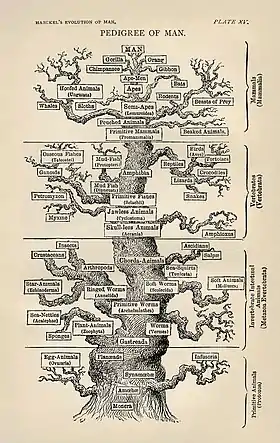Ikaria wariootia
Ikaria wariootia is an early example of a wormlike, 2–7 mm-long (0.1–0.3 in) bilaterian organism. Its fossils are found in rocks in South Australia that are estimated to be about 555 million years old. That falls within the Ediacaran period, about 14 million years before the Cambrian, when the Cambrian explosion happened, with the bilaterians becoming very widespread. [1][2][3]
| Ikaria wariootia | |
|---|---|
 | |
| Artist's restoration | |
| Scientific classification | |
| Kingdom: | Animalia |
| Clade: | Bilateria |
| Clade: | Nephrozoa |
| Genus: | †Ikaria Evans et al, 2020 |
| Species: | †I. wariootia |
| Binomial name | |
| †Ikaria wariootia Evans et al, 2020 | |
Discovery
Scott D. Evans, Ian V. Hughes, James G. Gehling, and Mary L. Droser published a paper in the Proceedings of the National Academy of Sciences of the United States of America on 23 March 2020, describing the finding and identification of I. wariootia.[3]
Etymology
The generic name is taken from the Adnyamathanha word for "meeting place" (Ikara, also the name for nearby Wilpena Pound) in recognition of the local indigenous people who originally lived in the region where the fossils were collected. The specific name refers to Warioota Creek, the type locality.[3]
Features
Over 100 Ikaria fossils have been found.[1] This is a simple imprints in the form of a small grain of rice (from 1.9 to 6.7 mm in length), slightly thickening to one end. The "anterior"/"posterior" differentiation may indicate that Ikaria was bilaterally symmetrical animal. No any other details of Ikaria anatomy were found on its fossils.[3]
On the same sandstone bed there are numerous trace fossils Helminthoidichnites. The animal that produced such traces moved or burrowed through thin layers of well-oxygenated sand on the ocean floor[2] as it sought sustenance and it had some volition, turning as it moved. It is thought to have moved by constricting muscles and should have a coelom, mouth, anus, and through-gut, in a similar way to a worm.[3]
The authors of the Ikaria description find that the size and morphology of Ikaria match predictions for the producer of the trace fossil Helminthoidichnites.[1][2][3] However, they note that they are not aware of examples of the connection of Ikaria with these trace fossils.[3] Therefore, the assumptions that Ikaria is the producer of these traces as well as the reasoning about Ikaria behavior, anatomy and taxonomy are speculative and may be erroneous.
Significance
This discovery is notable because while it has been long suspected that bilaterians evolved in the Ediacaran, for example Temnoxa and Kimberella, yet the vast majority of Ediacaran biota are very different from the animals that came to dominate the life on Earth in the Cambrian and until present day. Charles Darwin originally brought up the problem that most multicellular life, especially complex life, evolved at the beginning of the Cambrian period, 541 million years ago. This fossil appears to solve this problem.
See also
- Caveasphaera – Possible very early animal found in ancient rocks
- Life timeline – Life events since the formation of the Earth 4.54 billion years ago
- Organism – Any individual living physical entity
- Outline of biology – Hierarchical Wycklieffe Osano
- Outline of life forms – Overview of and topical guide to life forms
- Timeline of the evolutionary history of life – Current scientific theory outlining the major events during the development of life
- Urbilaterian – Possible simple urbilateran candidate
References
- Davis, Nicola (23 March 2020). "Fossil hunters find evidence of 555m-year-old human relative". The Guardian.
- "Ancestor of all animals identified in Australian fossils". m.phys.org. 23 March 2020.
- Evans, Scott D.; Hughes, Ian V.; Gehling, James G.; Droser, Mary L. (23 March 2020). "Discovery of the oldest bilaterian from the Ediacaran of South Australia". Proceedings of the National Academy of Sciences. 117 (14): 7845–7850. doi:10.1073/pnas.2001045117. PMC 7149385. PMID 32205432.
External links
- Biota (Taxonomicon)
- Life (Systema Naturae 2000)
- Vitae (BioLib)
- Wikispecies – a free directory of life

